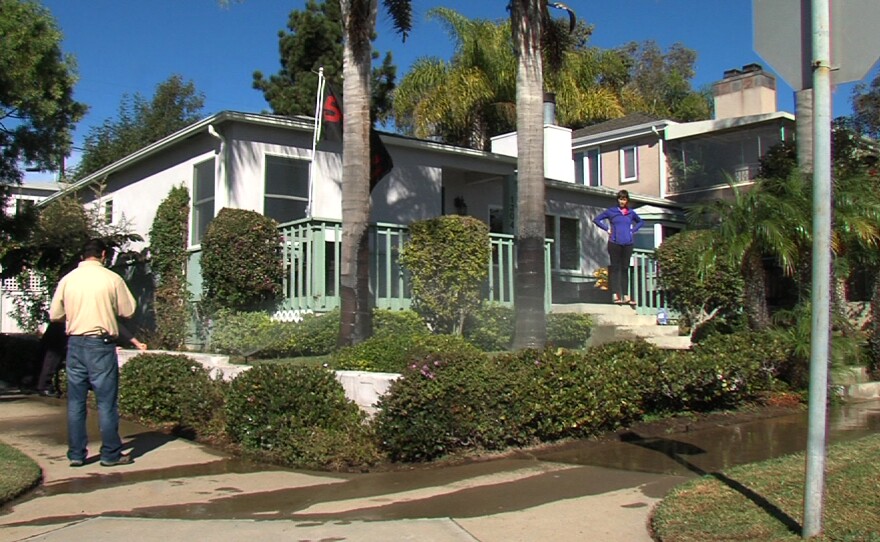The city of San Diego will give more teeth to mandatory water restrictions that have been in place since Nov. 1, 2014, Mayor Kevin Faulconer announced Wednesday.
Those rules limit when lawns can be watered and cars can be washed. They also require ornamental fountains to be turned off. Since November, the city has run a three strike system, where water rule breakers get a letter telling them to stop, then a follow-up visit and then are referred to code enforcement for a fine of $100, $250, or $500.
Mandatory Water Restrictions
• Watering lawns three days a week, and limited to seven minutes per station in November through May.
• Residences with odd-numbered addresses can water on Sundays, Tuesdays and Thursdays.
• Residences with even-numbered addresses can water on Saturdays, Mondays and Wednesdays.
• Apartments, condominiums and businesses can water on Mondays, Wednesdays and Fridays.
• Must use hoses with shut-off nozzles or timed-sprinkler systems to provide water to landscaped areas.
• Wash vehicles only before 10 a.m. or after 4 p.m. in November through May.
• Water potted plants, vegetable gardens and fruit trees before 10 a.m. or after 4 p.m.
• No watering lawns or plants on rainy days.
• Ornamental fountains must be turned off except for repairs.
"What we’re doing right now is we’ll be more active out there, driving the streets, and making sure that people are following the rules," said Halla Razak, the director of the city's public utilities department. "If we see any violation on the first contact we want to give a notice of violation, basically a formal warning. And then depending on what the violation is, give an amount of time, then we will check back, if things are not corrected that’s when a citation will be issued."
Razak said the city is going to hire additional staff to do this policing, but was not sure yet how many. When the water restrictions were first set up, the city had not hired any additional staff to follow up on reports of water rules being broken. By the end of December 2014, the city had hired three temporary employees.
No fines have been doled out to anyone for breaking water rules, Razak said. She said the city has received more than 990 complaints, and that 80 percent of violators corrected the problem after receiving a letter from the city.
Faulconer also announced the city is taking additional measures to curb its water use, including restarting a turf replacement rebate program, which pays homeowners who replace their grass lawns with native or drought resistant landscaping.
Razak said the city will pay $1.50 per square foot of lawn replaced, which is on top of a $2 per square foot rebate program from the Metropolitan Water District. Faulconer said he has set aside $200,000 for the program through June 30, and wants to include an extra $250,000 in his fiscal 2016 budget. His budget proposal will be released next week.
Faulconer also said the city will stop using drinking water on turf landscaped medians and is directing city staff to find ways to cut back on irrigation at parks and city-owned golf courses. He said parks are the city government’s largest water consumer.
While San Diego County’s water use was down in February compared with the same month last year, it soared 13 percent higher than for the same period in 2013. The county uses the month of February as its baseline for comparison.
RELATED: San Diego County’s Water Use Soars Amid Drought
Dana Friehauf, the water resources manager with the San Diego County Water Authority, said the region’s water use was down 4 percent from last year, but that it’s far short of the conservation goal, now at 25 percent.
"It sends a strong signal to the communities throughout San Diego County that they need to conserve," she said. "Each and every one of our residents and businesses need to conserve if we’re going to make it through this drought."
Friehauf said hot and dry temperatures are partly to blame. February 2015 was nearly 7 degrees warmer on average than February 2013.
Last week, Gov. Jerry Brown gave Californians an executive order to reduce water use by 25 percent. Faulconer said his moves came in response to that.
"These actions will help limit water waste and offer incentives for San Diegans to conserve," he said. "San Diego has been a statewide leader, cutting water use by double-digit numbers since 2007 – the last time our state faced a severe water crisis. But the past four years of unrelenting drought and record heat are moving California into uncharted territory. I’m confident we can lead by example once again because wasting water is never an option."







